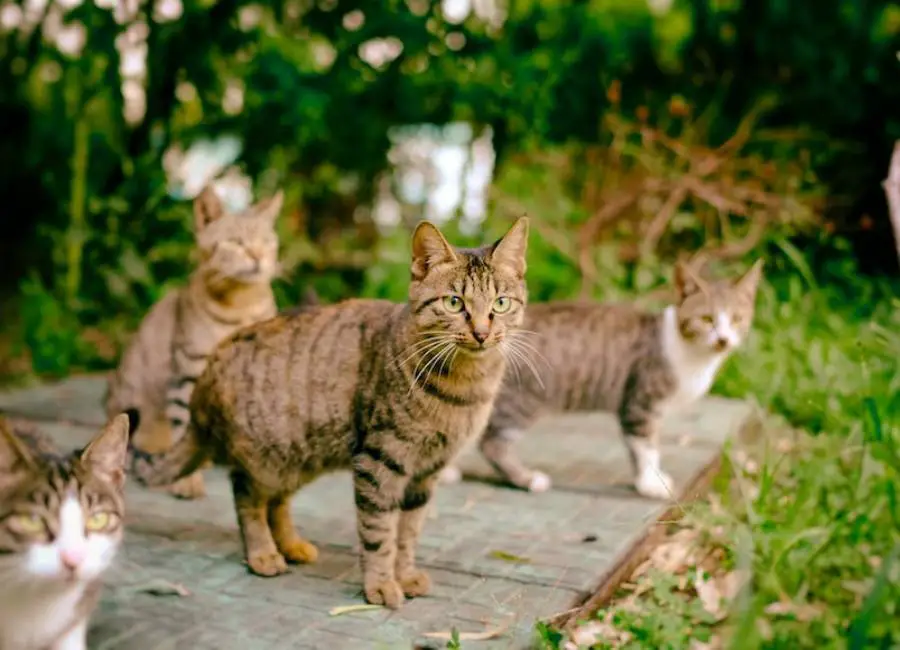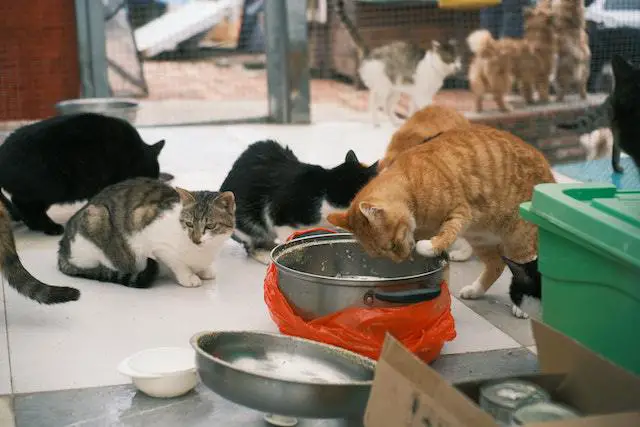9 Top Factors Affecting Feral Cats Life Expectancy

Let’s discuss the factors affecting feral cats life expectancy…
Hello, dear fellow cat lovers! Today, we’re going to talk about a topic that may be difficult for some of us to face – the life expectancy of feral cats.
We all know that cats are amazing creatures, and whether they’re our pets or not, we care about their well-being.
But what happens to those cats that roam the streets, without a home or designated owner? How long can they survive in the wild?
Join us as we explore the fascinating and sometimes heart-wrenching world of feral cats and their life expectancy.
What are feral cats?
Feral cats are unowned domestic cats that live outdoors and avoid human contact. They are different from stray cats, which are cats that once had a home and were socialized to people but have lost their homes or were abandoned.
Feral cats have not been socialized with humans and often live in colonies in urban or rural areas. They are sometimes referred to as community cats or free-roaming cats.
Feral cats are usually the wild offspring of domestic cats that were abandoned or lost and left to fend for themselves.
How long do feral cats live?
Feral cats’ lifespan can vary depending on various factors such as availability of food, shelter, and health, however, feral cats can live between 2 and 4 years and sometimes more than 4 years if they are sterilized, vaccinated, and well-fed.
If feral cats are sterilized and live in a colony with a caretaker, their lifespan may reach more than four years.
It is important to note that living in the wild can make them more susceptible to diseases and accidents, which can affect all feral cats’ lifespans.
Factors Affecting Feral Cats Life Expectancy

The following are some common factors affecting feral cats life expectancy:
1. Dangers of Traffic and Accidents
Road traffic and accidents pose a serious threat to feral cats in urban and suburban areas.
Wandering can cause them to come into contact with busy roads while looking for food or mates, increasing the risk of accidents or fatalities.
In areas with high levels of human activity, exposure to traffic presents a serious threat that reduces the life expectancy of feral cats.
Increasing the likelihood that injured feral cats will survive by raising public awareness about safe driving practices, putting in place traffic-calming measures in their natural habitats, and enlisting the aid of concerned neighbors.
2. Lack of Access to Food and Water
Feral cats need access to reliable, nourishing food and water sources in order to live healthy, long lives.
For the most part, feral cats rely on their natural hunting instincts to find food. However, feral cats might find it difficult to obtain regular meals in areas with little prey availability or intense competition.
This may cause malnutrition, which may cause organ damage, a weakened immune system, and other health issues that shorten their life expectancy.
Therefore, it is essential for the survival of feral cats to ensure that they have access to dependable food sources, such as community feeding stations or managed colonies.
3. Lack of Shelter and Environmental Conditions
Feral cats have a shorter lifespan when there is a lack of adequate shelter and a favorable environment. Extreme weather conditions, such as high heat, low temperature, or lots of rain, can be very dangerous to their health.
Feral cats may experience heatstroke, hypothermia, or other exposure-related illnesses in the absence of adequate shelter.
Insulated cat houses, secure hiding places, or special shelters for feral cats can provide protection from the elements and foster a safe environment where the cats can thrive.
4. Too Many Predators and Threats
The variety of natural predators and threats that feral cats face in their environment can have a significant impact on how long they live.
Larger creatures like coyotes, dogs, or even some types of birds could be a threat to feral cats. These encounters may lead to serious wounds, infections, or even attacks that are fatal.
Feral cats’ ability to roam freely and access resources may be constrained by the presence of predatory animals.
Reduce these risks and lengthen their life expectancy by creating secure, predator-proof environments, such as enclosed feral cat colonies or carefully chosen habitats.
5. Lack of Access to Veterinary Care
Another significant factor that may have an impact on the lifespan of feral cats is access to veterinary care, either being limited or nonexistent.
For the prevention and management of various health issues, regular vaccinations, parasite control, and medical treatments are imperative.
Feral cats are more vulnerable to illnesses, infections, and reproductive issues when they lack access to veterinary care.
FeLV (feline leukemia virus), FIV (feline immunodeficiency virus), and FIP (feline infectious peritonitis) are three common health issues among feral cats.
Programs for spaying and neutering animals are also essential for limiting population growth and lowering the risk of contracting certain diseases.
By making accessible veterinary care available, setting up mobile clinics, or collaborating with animal welfare groups, one can ensure that feral cats get the care they require and ultimately lengthen their lives.
6. Population Density and Competition
The number of feral cats in a region can have a big impact on how easily they can access resources and how happy they are in general. There is frequently fierce competition for food, shelter, and territory in areas with high population densities.
As a result of the competition, feral cats may experience higher levels of stress, which can lower their immune systems and increase their susceptibility to illnesses and infections.
High levels of stress can also cause behavioral problems and lessen a person’s capacity to adapt to changing environmental circumstances.
By managing the feral cat population and reducing competition for resources, effective population control strategies, like TNR programs, can increase the likelihood that they will live longer and in better health.
Learn more about different places feral cats sleep.
7. Reproductive Status
Feral cats’ reproductive status is a major factor in determining how long they live. Unspayed or neutered cats may have several litters annually, which contributes to overpopulation and a lack of resources.
Feral cats may suffer from malnutrition, an increased risk of infection, and complications during birth as a result of frequent pregnancies and the stress of raising young.
Programs for spaying and neutering cats not only aid in reducing the number of feral cats, but they also significantly lower the risk of developing certain illnesses like mammary tumors and uterine infections, enhancing their general health and lengthening their lifespan.
8. Lack of Human Interaction and Socialization

The amount of socialization and human contact that feral cats receive has a big impact on how long they live.
Feral cats who have interacted well with people and were socialized from a young age are more likely to accept human assistance, such as feeding, medical attention, and trap-neuter-return (TNR) programs.
These treatments can greatly enhance their general health and raise their likelihood of surviving longer.
By being patient and kind with feral cats, providing food and water on a regular schedule, and providing shelter and protection, people can help foster a trusting relationship with them that will ultimately benefit the cats’ health and longevity.
9. Lack of Community Awareness and Support
We’ll also look at lack of community awareness of and support for feral cats as our final factor. Feral cats live longer when communities actively manage their feral cat populations through TNR programs, provide food and water stations, and encourage responsible cat ownership.
Dispelling misunderstandings about these cats and educating the public about the significance of feral cat welfare contribute to creating a more forgiving and encouraging environment.
Collaboration between neighborhood residents, animal welfare groups, and local authorities can result in efficient management plans and the adoption of beneficial regulations, ultimately enhancing and extending the lives of feral cats.
Learn more about feral cat behaviors.
Ways to Improve Feral Cats Life Expectancy

Feral cats are unowned domestic cats that live outdoors and avoid human contact.
Their life expectancy is often shorter than that of indoor cats due to factors such as exposure to harsh weather, lack of access to medical care and regular food and water.
However, there are several ways to improve their life expectancy:
- Trap, neuter, and release (TNR) programs: TNR can control the population of feral cats, preventing them from reproducing and reducing the number of sick and starving cats.
- Provide regular access to food and clean water: Feral cats need food and water to survive and stay healthy. Providing regular, fresh food and water sources can significantly increase their life expectancy.
- Create shelters: Feral cats need a safe and warm place to rest and hide from predators. Providing cat shelters such as outdoor heated cat houses or straw bales can help keep feral cats safe and warm during cold weather.
- Veterinary care: Although feral cats may be difficult to handle, providing them with regular veterinary care is essential to their health and longevity. This includes vaccinations, parasite control, and treatment of any illnesses or injuries.
- Manage the environment: Feral cats can benefit from a managed environment that minimizes their exposure to dangers such as busy roads, toxic chemicals, and other hazards.
- Regular monitoring: Keeping track of feral cat populations can help identify any potential problems early and ensure that the cats are receiving the necessary care.
- Encourage adoption: Some feral cats may be socialized enough to be adopted into loving homes. Encouraging adoption and socialization of these cats can give them a chance at a better life.
- Educate the community: Educating the community about the importance of feral cat welfare can help to reduce the number of feral cats and increase support for TNR programs.
- Support local animal shelters and rescue groups: Local animal shelters and rescue groups play an important role in caring for feral cats. Supporting these organizations can help provide the cats with the care they need to live long and healthy lives.
Related Questions
What is the average life expectancy of feral cats?
The average life expectancy of a feral cat can vary depending on various factors such as access to food and shelter, disease prevalence, and environmental hazards. However, feral cats typically have a lifespan of 2–4 years or more, which is much shorter than their domesticated counterparts.
Can feral cats live longer than domesticated cats?
No, feral cats typically have a shorter lifespan than domesticated cats due to their constant exposure to environmental hazards and lack of access to medical care. Domesticated cats, on the other hand, often receive regular medical attention, nutritious food, and a safe environment, which helps to extend their lifespan.
Do feral cats have shorter lifespans than other wild animals?
Not necessarily. While feral cats do have a shorter lifespan compared to domesticated cats, it is not necessarily shorter than other wild animals. Factors such as living conditions and environmental hazards can vary widely between different species of wild animals, impacting their lifespan.
Learn more about the signs of a cat dying of old age.
What can be done to increase the life expectancy of feral cats?
One of the best ways to increase the life expectancy of feral cats is to practice Trap-Neuter-Return (TNR) to control their population and improve their health. TNR involves trapping feral cats, neutering them, and then returning them back to their original location. By doing this, feral cats can avoid overpopulation, disease outbreaks, and injuries that can shorten their lifespan.
Do feral cats face unique health challenges that can impact their lifespan?
Yes, feral cats are prone to certain health problems like fleas, ticks, and other parasites that can affect their overall health. They are also vulnerable to communicable diseases like feline leukemia virus and feline immunodeficiency virus. Without medical treatment, these conditions can significantly shorten their lifespan.
Learn more about weird cat behaviors before death.
Are there any ways to help feral cats live longer if they cannot be domesticated?
Yes, providing feral cats with food, water, and shelter can help them stay healthy and live longer if they cannot be domesticated. Building outdoor cat shelters, providing consistent food and water sources, and monitoring their health can all improve their quality of life and extend their lifespan.
Learn more about stray pregnant cat behaviors.
Conclusion
In conclusion, if you’re a cat lover or just curious about felines, you now know more about the life expectancy of feral cats.
Although it’s difficult to estimate, it’s safe to say that with proper care and attention, feral cats can live long, fulfilling lives despite the challenges they may face.
So, next time you come across a stray feline, take a moment to appreciate the beauty and resilience of our furry friends. Who knows, you might just end up saving a life!
